

Compact Muon Solenoid
LHC, CERN
| CMS-PAS-EXO-14-014 | ||
| Search for heavy Majorana neutrinos in e±e± + jets and e±μ± + jets events in proton-proton collisions at √s= 8 TeV | ||
| CMS Collaboration | ||
| September 2015 | ||
| Abstract: We report a search for heavy Majorana neutrinos (N) decaying into a W boson and a lepton using the CMS detector at the Large Hadron Collider. We search for a signature of two same-sign electrons and two jets or a same-sign electron-muon pair and two jets using 19.7 fb−1 of data collected during 2012 in proton-proton collisions at a center-of-mass energy of 8 TeV. We find the data to be consistent with the expected standard model background and upper limits are set on |VℓN|2, as a function of Majorana neutrino mass from 40-500 GeV/c2, where VℓN is the mixing element of the heavy neutrino with the standard model neutrino. The upper limits obtained for |VeN|2 (|VeNV∗μN|) are 0.022 (0.009) for mN= 90 GeV/c2, 0.016 (0.009) for mN= 200 GeV/c2, and 0.72 (0.47) for mN= 500 GeV/c2. These results extend considerably the regions excluded by previous direct searches. | ||
|
Links:
CDS record (PDF) ;
Public twiki page ;
CADI line (restricted) ; Figures are also available from the CDS record. These preliminary results are superseded in this paper, JHEP 04 (2016) 169. |
||
| Figures | |

png ; pdf |
Figure 1:
The Feynman diagram for resonance production of a Majorana neutrino (N). The charge-conjugate diagram results in a ℓ−ℓ−qˉq′ final state. |
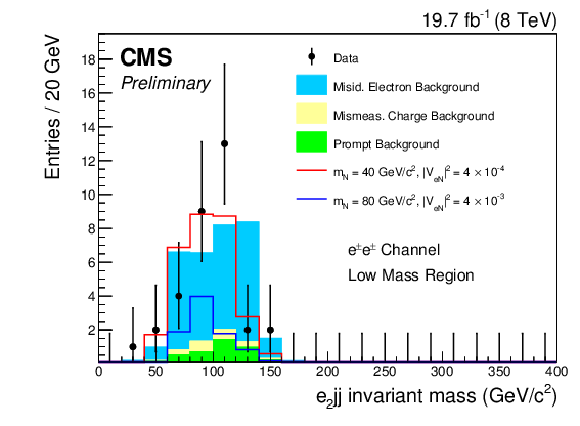
png ; pdf |
Figure 2-a:
Kinematic distributions for the low-mass selection (dielectron channel) after all selection cuts are applied except for the final optimization requirement: [a] Invariant mass of the trailing pT lepton and the two selected jets, [b] Invariant mass of two leptons and the two selected jets and [c] the pT of the leading lepton. The plot shows the data, backgrounds, and two choices for the heavy Majorana neutrino signal: mN= 40 GeV/c2, |VeNVμN∗|=4×10−4 and mN= 80 GeV/c2, |VeNVμN∗|=4×10−3. The prompt background includes diboson (VV), Higgs boson, triboson (VVV) and tˉtV production and is stacked along with the backgrounds from misidentified leptons and mismeasured charge. |

png ; pdf |
Figure 2-b:
Kinematic distributions for the low-mass selection (dielectron channel) after all selection cuts are applied except for the final optimization requirement: [a] Invariant mass of the trailing pT lepton and the two selected jets, [b] Invariant mass of two leptons and the two selected jets and [c] the pT of the leading lepton. The plot shows the data, backgrounds, and two choices for the heavy Majorana neutrino signal: mN= 40 GeV/c2, |VeNVμN∗|=4×10−4 and mN= 80 GeV/c2, |VeNVμN∗|=4×10−3. The prompt background includes diboson (VV), Higgs boson, triboson (VVV) and tˉtV production and is stacked along with the backgrounds from misidentified leptons and mismeasured charge. |

png ; pdf |
Figure 2-c:
Kinematic distributions for the low-mass selection (dielectron channel) after all selection cuts are applied except for the final optimization requirement: [a] Invariant mass of the trailing pT lepton and the two selected jets, [b] Invariant mass of two leptons and the two selected jets and [c] the pT of the leading lepton. The plot shows the data, backgrounds, and two choices for the heavy Majorana neutrino signal: mN= 40 GeV/c2, |VeNVμN∗|=4×10−4 and mN= 80 GeV/c2, |VeNVμN∗|=4×10−3. The prompt background includes diboson (VV), Higgs boson, triboson (VVV) and tˉtV production and is stacked along with the backgrounds from misidentified leptons and mismeasured charge. |
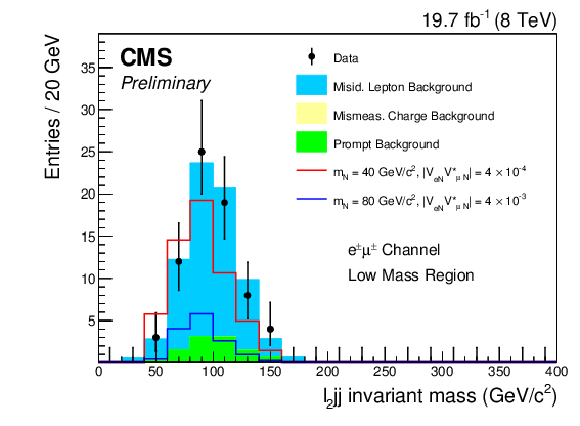
png ; pdf |
Figure 3-a:
Kinematic distributions for the low-mass selection (electron-muon channel) after all selection cuts are applied except for the final optimization requirement: [a] Invariant mass of the trailing pT lepton and the two selected jets, [b] Invariant mass of two leptons and the two selected jets and [c] the pT of the leading lepton. The plot shows the data, backgrounds, and two choices for the heavy Majorana neutrino signal: mN= 40 GeV/c2, |VeNVμN∗|=4×10−4 and mN= 80 GeV/c2, |VeNVμN∗|=4×10−3. The prompt background includes diboson (VV), Higgs boson, triboson (VVV) and tˉtV production and is stacked along with the backgrounds from misidentified leptons and mismeasured charge. |

png ; pdf |
Figure 3-b:
Kinematic distributions for the low-mass selection (electron-muon channel) after all selection cuts are applied except for the final optimization requirement: [a] Invariant mass of the trailing pT lepton and the two selected jets, [b] Invariant mass of two leptons and the two selected jets and [c] the pT of the leading lepton. The plot shows the data, backgrounds, and two choices for the heavy Majorana neutrino signal: mN= 40 GeV/c2, |VeNVμN∗|=4×10−4 and mN= 80 GeV/c2, |VeNVμN∗|=4×10−3. The prompt background includes diboson (VV), Higgs boson, triboson (VVV) and tˉtV production and is stacked along with the backgrounds from misidentified leptons and mismeasured charge. |
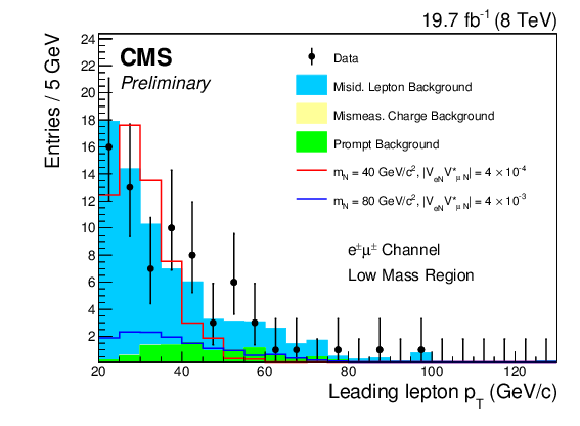
png ; pdf |
Figure 3-c:
Kinematic distributions for the low-mass selection (electron-muon channel) after all selection cuts are applied except for the final optimization requirement: [a] Invariant mass of the trailing pT lepton and the two selected jets, [b] Invariant mass of two leptons and the two selected jets and [c] the pT of the leading lepton. The plot shows the data, backgrounds, and two choices for the heavy Majorana neutrino signal: mN= 40 GeV/c2, |VeNVμN∗|=4×10−4 and mN= 80 GeV/c2, |VeNVμN∗|=4×10−3. The prompt background includes diboson (VV), Higgs boson, triboson (VVV) and tˉtV production and is stacked along with the backgrounds from misidentified leptons and mismeasured charge. |

png ; pdf |
Figure 4-a:
Kinematic distributions for the high-mass selection (dielectron channel) after all selection cuts are applied except for the final optimization requirement: [a] Invariant mass of the trailing pT lepton and the two selected jets, [b] Invariant mass of two leptons and the two selected jets and [c] the pT of the leading lepton. The plot shows the data, backgrounds, and two choices for the heavy Majorana neutrino signal: mN= 100 GeV/c2, |VeNVμN∗|= 0.015 and mN= 300 GeV/c2, |VeNVμN∗|= 0.5. The prompt background includes diboson (VV), Higgs boson, triboson (VVV) and tˉtV production and is stacked along with the backgrounds from misidentified leptons and mismeasured charge. |

png ; pdf |
Figure 4-b:
Kinematic distributions for the high-mass selection (dielectron channel) after all selection cuts are applied except for the final optimization requirement: [a] Invariant mass of the trailing pT lepton and the two selected jets, [b] Invariant mass of two leptons and the two selected jets and [c] the pT of the leading lepton. The plot shows the data, backgrounds, and two choices for the heavy Majorana neutrino signal: mN= 100 GeV/c2, |VeNVμN∗|= 0.015 and mN= 300 GeV/c2, |VeNVμN∗|= 0.5. The prompt background includes diboson (VV), Higgs boson, triboson (VVV) and tˉtV production and is stacked along with the backgrounds from misidentified leptons and mismeasured charge. |
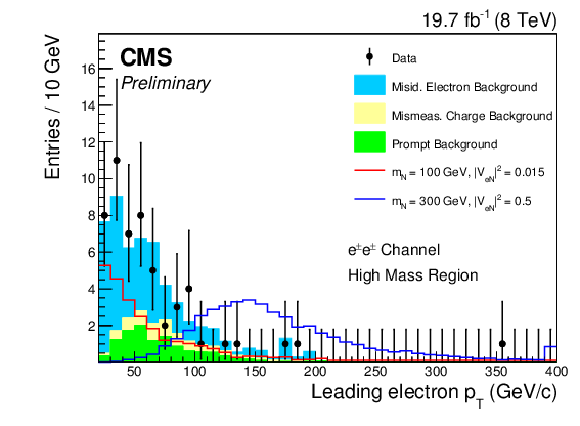
png ; pdf |
Figure 4-c:
Kinematic distributions for the high-mass selection (dielectron channel) after all selection cuts are applied except for the final optimization requirement: [a] Invariant mass of the trailing pT lepton and the two selected jets, [b] Invariant mass of two leptons and the two selected jets and [c] the pT of the leading lepton. The plot shows the data, backgrounds, and two choices for the heavy Majorana neutrino signal: mN= 100 GeV/c2, |VeNVμN∗|= 0.015 and mN= 300 GeV/c2, |VeNVμN∗|= 0.5. The prompt background includes diboson (VV), Higgs boson, triboson (VVV) and tˉtV production and is stacked along with the backgrounds from misidentified leptons and mismeasured charge. |
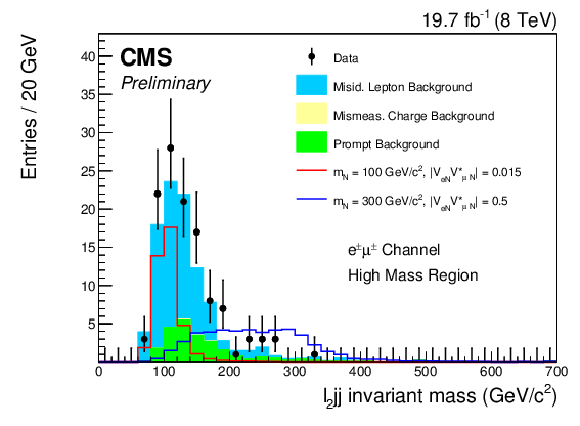
png ; pdf |
Figure 5-a:
Kinematic distributions for the high-mass selection (electron-muon channel) after all selection cuts are applied except for the final optimization requirement: [a] Invariant mass of the trailing pT lepton and the two selected jets, [b] Invariant mass of two leptons and the two selected jets and [c] the pT of the leading lepton. The plot shows the data, backgrounds, and two choices for the heavy Majorana neutrino signal: mN= 100 GeV/c2, |VeNVμN∗|= 0.015 and mN= 300 GeV/c2, |VeNVμN∗|=0.5. The prompt background includes diboson (VV), Higgs boson, triboson (VVV) and tˉtV production and is stacked along with the backgrounds from misidentified leptons and mismeasured charge. |
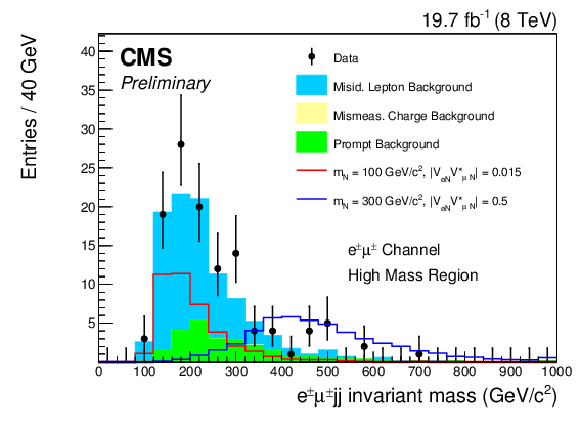
png ; pdf |
Figure 5-b:
Kinematic distributions for the high-mass selection (electron-muon channel) after all selection cuts are applied except for the final optimization requirement: [a] Invariant mass of the trailing pT lepton and the two selected jets, [b] Invariant mass of two leptons and the two selected jets and [c] the pT of the leading lepton. The plot shows the data, backgrounds, and two choices for the heavy Majorana neutrino signal: mN= 100 GeV/c2, |VeNVμN∗|= 0.015 and mN= 300 GeV/c2, |VeNVμN∗|=0.5. The prompt background includes diboson (VV), Higgs boson, triboson (VVV) and tˉtV production and is stacked along with the backgrounds from misidentified leptons and mismeasured charge. |
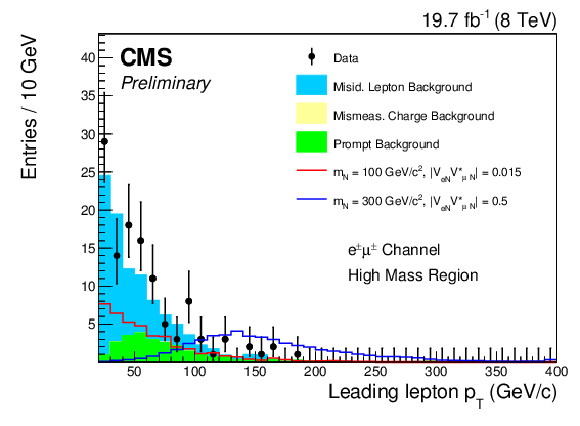
png ; pdf |
Figure 5-c:
Kinematic distributions for the high-mass selection (electron-muon channel) after all selection cuts are applied except for the final optimization requirement: [a] Invariant mass of the trailing pT lepton and the two selected jets, [b] Invariant mass of two leptons and the two selected jets and [c] the pT of the leading lepton. The plot shows the data, backgrounds, and two choices for the heavy Majorana neutrino signal: mN= 100 GeV/c2, |VeNVμN∗|= 0.015 and mN= 300 GeV/c2, |VeNVμN∗|=0.5. The prompt background includes diboson (VV), Higgs boson, triboson (VVV) and tˉtV production and is stacked along with the backgrounds from misidentified leptons and mismeasured charge. |
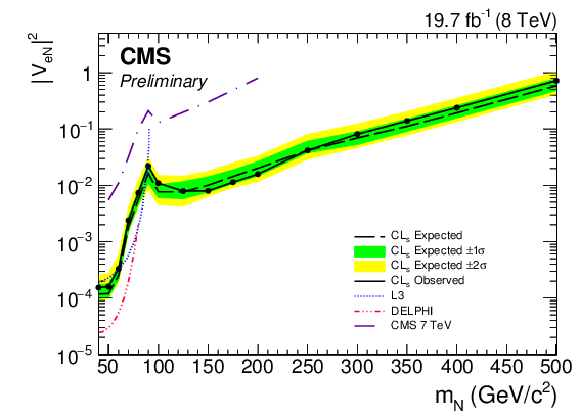
png ; pdf |
Figure 6-a:
[a] Exclusion region at 95% CL in the square of the heavy Majorana neutrino mixing parameter as a function of the heavy Majorana neutrino mass: (|VeN2| vs. mN). The dashed black curve is the expected upper limit, with one and two standard-deviation bands shown in dark green and light yellow, respectively. The solid black curve is the observed upper limit. Also shown are the upper limits from other direct searches: L3 [21], DELPHI [20], and the upper limits from CMS obtained with the 2011 LHC data at √s=7 TeV [29]. [b] An expanded view of the region 40 GeV/c2 <mN< 200 GeV/c2. |

png ; pdf |
Figure 6-b:
[a] Exclusion region at 95% CL in the square of the heavy Majorana neutrino mixing parameter as a function of the heavy Majorana neutrino mass: (|VeN2| vs. mN). The dashed black curve is the expected upper limit, with one and two standard-deviation bands shown in dark green and light yellow, respectively. The solid black curve is the observed upper limit. Also shown are the upper limits from other direct searches: L3 [21], DELPHI [20], and the upper limits from CMS obtained with the 2011 LHC data at √s=7 TeV [29]. [b] An expanded view of the region 40 GeV/c2 <mN< 200 GeV/c2. |
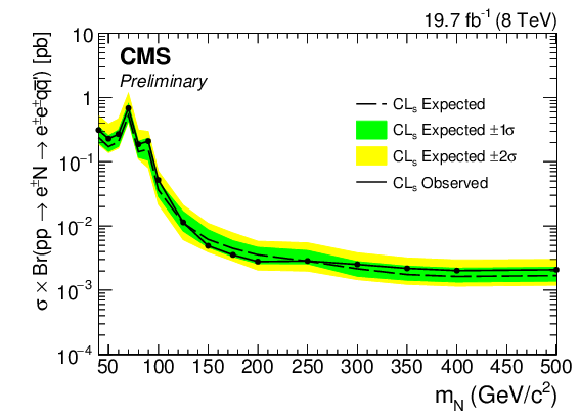
png ; pdf |
Figure 7:
Exclusion region at 95% CL in the cross section times branching fraction, as a function of the heavy Majorana neutrino mass. The dashed curve is the expected upper limit, with one and two standard-deviation bands shown in dark green and light yellow, respectively. The solid black curve is the observed upper limit. |
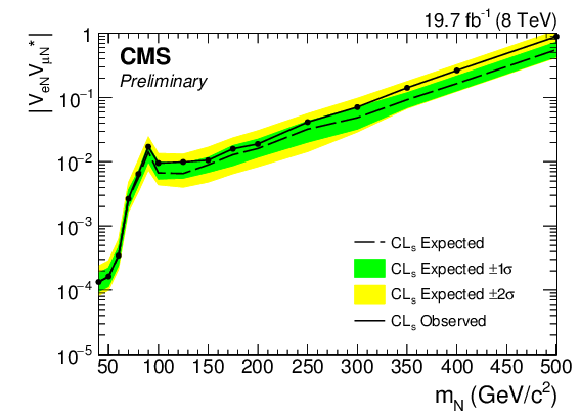
png ; pdf |
Figure 8-a:
[a] Exclusion region at 95% CL in the square of the heavy Majorana neutrino mixing parameter as a function of the heavy Majorana neutrino mass: (|VeNVμN∗| vs. mN). The dashed black curve is the expected upper limit, with one and two standard-deviation bands shown in dark green and light yellow, respectively. The solid black curve is the observed upper limit. [b] An expanded view of the region 40 GeV/c2 <mN< 200 GeV/c2. |

png ; pdf |
Figure 8-b:
[a] Exclusion region at 95% CL in the square of the heavy Majorana neutrino mixing parameter as a function of the heavy Majorana neutrino mass: (|VeNVμN∗| vs. mN). The dashed black curve is the expected upper limit, with one and two standard-deviation bands shown in dark green and light yellow, respectively. The solid black curve is the observed upper limit. [b] An expanded view of the region 40 GeV/c2 <mN< 200 GeV/c2. |

png ; pdf |
Figure 9:
Exclusion region at 95% CL in the cross section times branching fraction, as a function of the heavy Majorana neutrino mass. The dashed curve is the expected upper limit, with one and two standard-deviation bands shown in dark green and light yellow, respectively. The solid black curve is the observed upper limit. |

|
Compact Muon Solenoid LHC, CERN |

|

|

|

|

|

|